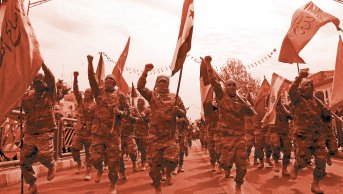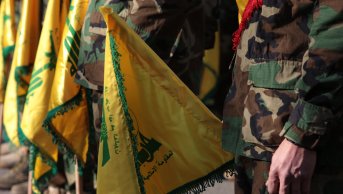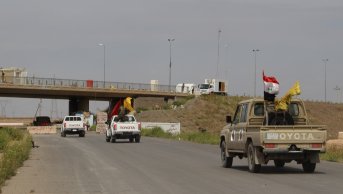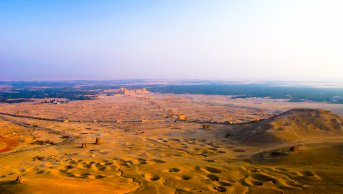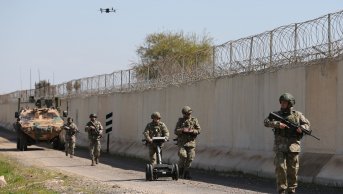Pro-Regime Palestinian Militias in Syria
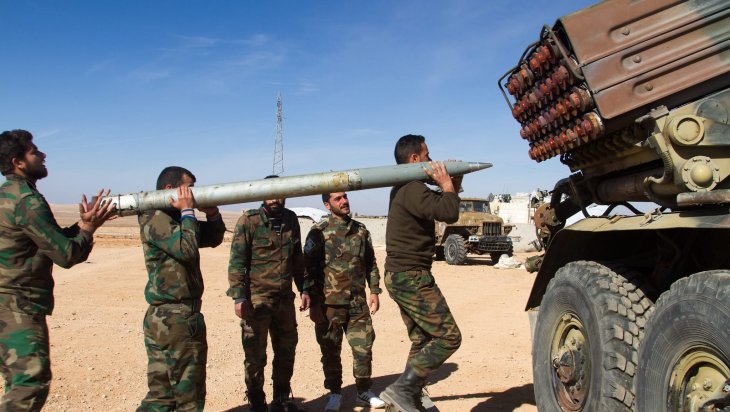
It is clear that when it comes to non-state actors in the Syrian civil war, pro-regime forces are almost as varied as the opposition. Most notably, Palestinians are worth mentioning with their ardor and cooperation both as the regime’s sponsors, and as the pro-regime militias that have different ethnicity and sectarian/religious features. According to data provided by UNRWA, before the start of the war, 526 thousand Palestinian refugees were living in the nine refugee camps across the country and most notably in Damascus. After the first 5 intense years of the war, this number dropped to 438 thousand in 2016. During this time, especially the educated and affluent Palestinians fled the country. According to the latest UNRWA data, 60% of the 400 thousand Palestinian refugees currently living in Syria had to be relocated at least once within the country. In addition to problems such as not having access to basic supplies due to economic problems, they can also become direct targets. Such was the case when Assad forces besieged the Yarmouk camp, which fueled the migration wave within the country.
Palestinian refugees were not only targeted by the conflict but they also joined it and chose different sides just like the Syrians. Anti-Assad Palestinian militias acted together with various opposition groups that were influential in Damascus and its vicinity. In addition to small groups like Aknaf Beit al-Maqdis and Liwa al-Asifa, which were predominantly Palestinian, large groups like Jaysh al-Islam and the Nusra Front also comprised large numbers of Palestinian militias. However, Palestinian militias are more prevalent among pro-Assad groups, including small and medium-sized militia groups such Fatah al-Intifada, Quvat al-Awda, Liwa al-Jalil, Quvat al-Jalil, Popular Front for the Liberation of Palestine, as well as large groups such as Palestine Liberation Army and Liwa al-Quds.
When Islamist groups came together in Palestine to counter Arabic nationalism, a similar trend in Syria was triggered. For this reason, it is possible to say that most of the pro-Assad militias are Arab nationalists. However, it must be also stated that some Palestinian militias that side with Hezbollah and Iran forces, adopt policies that are in line with the stances of Iran and Hezbollah toward the Syrian civil war, rather than the norms of Arab nationalism.
Palestinian Legion of Damascus Regime: Palestine Liberation Army
If we are to look at the major pro-Assad Palestinian militia groups, we can say that the Palestine Liberation Army (PLA) is not only ideologically close to the Assad regime, but it also closely cooperates and liaises with it. From the Palestinian conscripts directly obeying the orders of the regime forces in its operations in the capital city of Damascus, it can be said that they act like a Palestinian legion of the regime army. Even though in theory the conscripts are independent of the regime army, the PLA enjoys organic bonds with the military units of the regime. They receive training at the military schools of the regime as well as at various regime agencies. The fact that former PLA leader Tariq Hadra’s brother Hazem el-Hadra acted as the Chief of Air Forces in Assad’s army, is another example that shows the closeness of relations between PLA and the regime.
According to the official reports of PLA, which fought in conflicts on the regime’s side in Damascus and its rural areas, Hama, Daraa, Suwayda, and Idlib, at least 300 militias died during the clashes. Again, according to their accounts, the organization had 6 thousand militias two years ago but lost members after the regime forces detained and tortured to death some of them after refusing to fight the opposition groups. It is claimed that at least 30 PLA militias were tortured to death by the regime forces.
Palestinian Legion of Moscow: Liwa al-Quds
Liwa al-Quds, which was founded in Aleppo in 2013, and which consists of Palestinians, actively took part in the most bloody conflicts fought by the regime. The group fought in Aleppo, Damascus, Deir ez-Zor, Hama, Idlib, and Humus. The conflicts in Aleppo and the desert area were particularly important milestones in the war. Liwa al-Quds, which is an Aleppo-based group and which is one of the important secondary players in the regimes’ fight against the opposition in Aleppo, fought on fronts such as Nayrab, Handarat, and Nubl-Zahra. During this time, the group received support from the regime’s air intelligence unit, with which it has been closely cooperating since its foundation, as well as technical and financial support from the IRGC.
Liwa al-Quds, which played a part in the land occupation of the regime in Aleppo and which closely cooperated with Iranian groups, got closer to Russia after the second half of the civil war. During this time, Russia snatched the role from Iran as the main pro-regime player in the Syrian civil war. Russians formed the 5th Army Corps and tried to convince militia forces like Liwa al-Quds to be their military extensions on the field. This period started with meetings, continued with financial and intelligence support, and ended up with the training of Liwa al-Quds militias by Russian special forces which also supplied them with modern Russian weapons. Liwa al-Quds, which has been active together with the Russia-back 5th Army Corps in Deir ez-Zor – Humus line, fought in many conflict areas like Tedmur, Sukhna, Shoula, and Kabajeb, and engaged in bloody conflicts with ISIS, during which it lost many militias. Even though the group cooperates with Iran-backed groups such as Liwa Fatemiyoun, it sometimes engages under tension with various military groups of the regime in Hama and Deir ez-Zor and especially with the Iran-backed 4th armored division.
Conclusion
As of 2021, the Assad regime, due to its fractured structure, is no longer a unified force but instead consists of many non-state, armed actors of varying sizes. And some Palestinian refugees, just like the militia groups made up of the same religious and sectarian minorities, became the armed extensions of the regime on the field. Considering the Assad regime’s close cooperation with various Palestinian armed groups and their political leaders since the 1970s, its relations with Hezbollah, and its anti-Israel rhetoric in the foreign policy, it is only natural that the regime used Palestinian groups as armed forces in the war. However, the military and economic losses the regime sustained during the war affected its influence on the Palestinian militia groups. Liwa al-Quds’ close relations with the IRGC and pro-Iran groups when it was most effective in Aleppo, and its subsequent rapprochement with Russia, which turned it into a trained-armed group, show that the Assad regime is not the only option for Palestinian militias. Palestinian militias might soon encounter intense control and domination attempts of Tehran and Moscow, after having played important roles in Damascus and the desert area. If this happens, the Assad regime, which is already in need of Moscow and Tehran militarily, will no longer be able to see this group as a “guaranteed supporter”.

